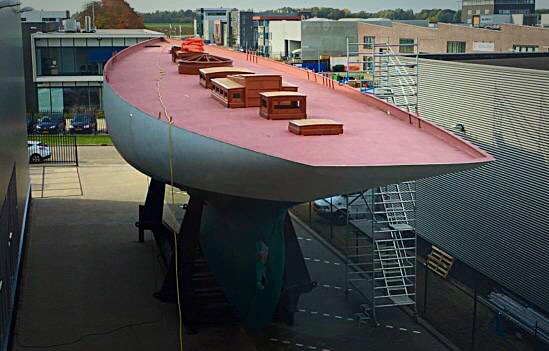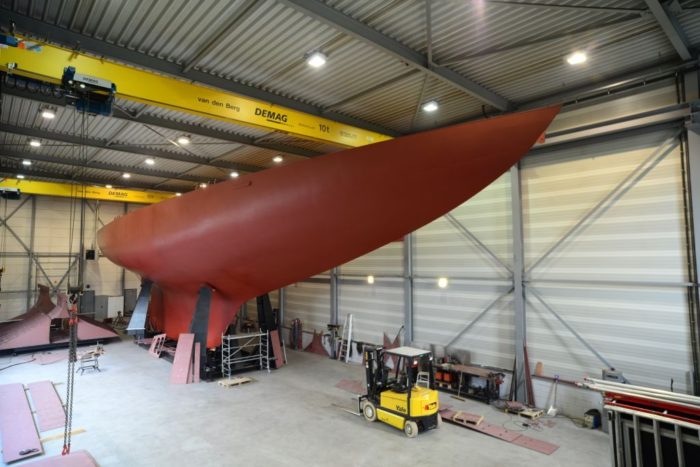
Sail Number:
Type: (Recreation) Two-masted topsail gaff schooner
LOA: 176’9” / 53.88m – LOD: 120’8” / 36.78m- LWL: 85’10” / 26.16m – Beam: 24’2” / 7.37m – Draft: 16’7” / 5.06m – Displacement: 178 tonnes (est.) – Ballast: – Hull material: Welded Steel -Sail Area: 1071 m2 – Designer: N.G. Herreshoff- Consulting Naval Architect: Wester Naval Architect – Built by: Graafship BV. Netherlands – Designed Year: 1903
E-Book: The Schooner Ingomar – Original Owner: Ed Kastelein – Location: Holland
Historical:
It all started back in 1903 when railway magnate Morton Plant (Commodore of the Larchmont Yacht Club) called Nathanael Herreshoff with a simple order brief for a winning Class B schooner to race & cruise American waters and head over to Europe to win the much coveted Cape May Cup. Until that time all Herreshoff designed racing yachts had been single mast and with Ingomar the Wizard of Bristol turned out the first of nine extraordinary successful schooners. In his notes Herreshoff calls Ingomar “a wonderfully good schooner that easily proved to be the fastest of her type”. He wrote that he sailed her a few times and was well pleased. Charlie Barr, by then 3 time America’s Cup winner, became Ingomar’s captain and he too was well pleased. After crossing the Atlantic in 15 days he wrote to Herreshoff; “Ingomar is as good as cruising yacht as you will find anywhere”. Little did he know then because when he started racing Ingomar that extraordinary cruising yacht brought home 17 trophies in a single season. Only the legendary schooner America has ever campaigned with more success.
Ingomar was built side by side with Reliance, the greatest of all America’s Cup yachts. With Lipton’s 1903 Challenge to lift the Cup, the pace of construction for Reliance prevailed but Ingomar surely benefitted from the incredible development and refinement of this quintessential racing yacht. Her fittings were light, elegant yet immensely strong, her deck lay-out and set up of the rig reflected all that was learned from the past Cup yachts and much admired. Such was her perfection that Ingomar’s rig served as model for all Herreshoff schooners to follow.
Ingomar’s first outing in 1903 proved to be a sign of things to come and with great dominance she won the Astor Cup for Schooners and from there on she took the schooner world by storm winning every yacht club run in her first season. Morton Plant had a mission to race the big class in Europe and win back the Cap May Cup which the English yacht Genesta won in 1885. Since then this prestigious trophy was raced for and held in English hands. The trophy was last won by King Edward’s Britannia in 1893 however to embarrassment of the trophy was lost. Winsor castle was ransacked to no avail until the trophy was found at the Royal Sandringham estate, but by then it was to late and with profound apologies it was returned to the New York Yacht Club. Apologies were naturally excepted in the best spirit and later that year the Cup was raced for in American waters and won by the 3-Masted schooner Atlantic.
Ingomar raced both British and German waters and was met by the best schooners and cutters of her time. Her performance was so dominant that she received an arbitrary handicap allowing other yachts some silver too. Even under those circumstances she won 12 firsts, 4 seconds and one third. Had she been built under the Universal Rule then her racing career would have extended for many years but when the NYYC adopted that new rating rule her competitive days where over and she resumed her life as a fast & luxurious cruising yacht.

Sadly, while on a private cruise On November 10th, 1931 Ingomar was lost upon hitting the Frying Pan Shoals, off Cape Fear, North Carolina. Her sinking as reported by Taylor, William H.
“With nine men aboard, under Captain Leif Sparre, Ingomar sailed from Oxford on February 18th, bound for Charleston, S. C, to pick up Mr. Hoffman and a party. Fog delayed her inside the Capes, but she passed Cape Henry bell buoy at 4.00 p.m. on the nineteenth and headed down the coast under sail and power. On the evening of the twentieth, with a moderate N.N.W. breeze, she was logging nine or ten knots when the skipper went below, leaving the mate in charge. At 11:20 that night the mate picked up two lights which he believed to be the lightship and gas buoy on the Frying Pan, and the course was presently altered. As it turned out, the lightship had been moved offshore since Ingomar’s charts were printed and one of the lights they saw was the lighthouse on Cape Fear.”
“At 12:10 a.m. Ingomar struck hard on the tail of the Frying Pan, slid over into deep water, and then, with a heavy sea driving her, went on again and began to pound. For six hours the seas lifted and pounded her on the shoal and washed her decks, smashing in her skylights and hatches and gradually beginning to fill her. Soon there was enough water below to set the heavy cabin furniture adrift, and as she rolled and pounded, the furniture smashed the bulkheads out of her until she was one seething, open room from stem to stern, with wreckage batting about so that no man dared go below decks, though it was scarcely less perilous on topside as the seas washed her. This loose debris, the captain believes, broke off some of her plumbing or other openings through the hull and hastened her filling.”
“Despite the hammering, the old ship refused to break up and at six o’clock in the morning she had washed clean over the shoal and was afloat in the deeper water to leeward. They anchored, but with the motor pump out of commission, the water gained two inches an hour despite desperate work with hand pumps and buckets, and at 10.00 a.m. they made sail again and headed for where they supposed the lightship to be, hoping that if they reached her she could signal help to them.”
“Failing to sight the ship as expected, and with Ingomar settling under them, they finally headed her for the beach, but by then she was almost unmanageable and settling faster than ever, with her smashed portholes now awash. At 4:30 they launched the lifeboat.”
“By great good fortune Mr. Hoffman had equipped Ingomar with a big, new, steel, motor lifeboat which he intended to use for fishing when he got south. The motor was soaked and useless, and they hove it overboard to lighten her and bent to their oars. The schooner sank a few minutes after they left her, in the deep water to the southward of the Frying Pan, and there she will lie as long as the steel lasts.”
“Twenty-two hours of rowing brought the shipwrecked crew to the beach at Cape Fear where the Coast Guard station took them in. The keeper of Cape Fear Light had reported seeing flares that Captain Sparre sent up after the wreck, but had misjudged their distance offshore so that two Coast Guard boats that had set out to investigate had gone only as far as the slue and failed to see her. Had they found her in time and towed her to shelter, Ingomar might still have made that trip abroad this summer.” (Source: Taylor, William H. “Vale Ingomar! A Yacht Long Famous in the Annals of Yacht Racing Meets Her End.” Yachting Magazine, May, 1931, p. 63-64, 132, 134, 136.)
Ingomar today

With the fleet of large classic yachts growing every year the scene for schooner racing is becoming one of the most attractive and exciting in the Mediterranean Sea. Here you will find Mariette, Elena, Eleonora, Orion, Altair and many others. Ingomar was not designed to any rating rule and her designer Nathanael Herreshoff was therefore not restricted in hull shape or sailplan. The result was the quintessential hybrid between a fast cruising yacht and a winning racing schooner. In today’s classic fleet she fits right in the slot, on deck slightly shorter than Elenora but her sparred length and sailarea exceeding that of her bigger sister. Her low relatively low displacement with large sailplan will undoubtedly make her the ultimate light air flyer of the fleet, and light air is the predominant condition in the Med.
But Ingomar is not an all-out racing yacht, who could better state this as the legendary Charlie Barr, who wrote to N.G. Herreshoff; “Ingomar is as good as cruising yacht as you will find anywhere”. And that is the concept on which Ed Kastelein modelled Ingomar. Ingomar was built for Ed Kastelein, she is his fourth large schooner and all and everything he knows goes into this project. Of course she is built in steel Graaf Ship of Dordrecht, Holland, known as one of the best Dutch shipbuilders. Her hull is strong and among the fairest ever built. A wonderfully elegant and comfortable interior for both guests and crew, a large galley to cater the guests but also dockside parties. Not adopted but recreated to sail with guests and enter a successful charter career. A traditional, authentic yet simple to operate rig with a deck crew in full service of no more than eight.
Construction will continue once the owner sells Atlantic. In the meantime, she is for sale for anyone interested in finishing her. Ingomar presents an opportunity for anyone that wishes to gain from the owners experience in building his recently recreated schooners such as Eleonora, Elena and Atlantic. Thorough historical research has revealed some 160 original building and construction plans, all highly detailed and complete. Her beauty and success made her one of the best documented yachts of her time and many of the original images have survived and will help recreate this yacht to her original glory.
Note: The boat is currently lying in Holland with the hopes of bringing her to America for completion.
Please contact John Maxwell Brooklin Boatyard at 207-359-2193
Provenance
Owner/Guardian: Ed Kastelein
